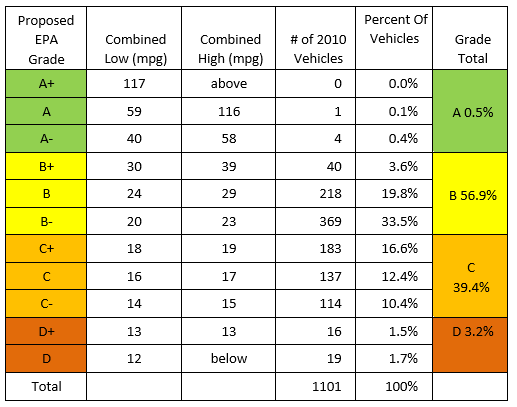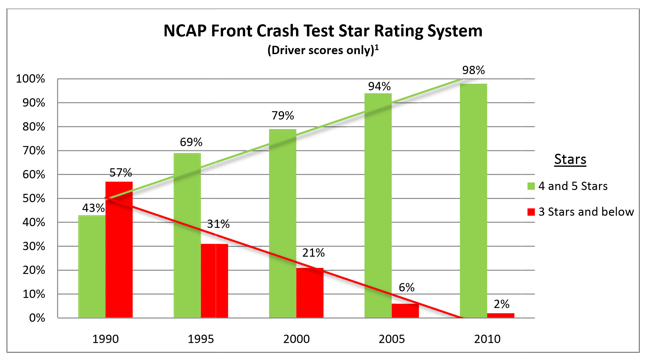Washington D.C.—Although auto dealers and manufacturers are objecting to providing consumers with a simple fuel economy grading system, the informative and potentially behavior changing proposed EPA fuel economy labels represent a giant step forward in our efforts to improve vehicle fuel efficiency and reduce our dependence on foreign oil.
Alliance of Automobile Manufacturers CEO David McCurdy, who represents Toyota, GM, Ford, and eight other automakers, said the “proposed letter grade falls short because it is imbued with school-yard memories of passing and failing.”
“That’s precisely the point,” said Jack Gillis, CFA’s Director of Public Affairs and Author of The Car Book. “We all understand the difference between an ‘A’ and a ‘D’ and that’s what scares the car makers.” And they’re afraid for good reason. We took a look at how last year’s vehicles would have fared under the proposed grading system and less than 1% would get “A”s. On the other hand, over 40% get “C”s or lower.
The following table shows how the 2010 models would be graded. (Note: CFA plans to conduct the same analysis as soon as the EPA releases fuel economy figures for all 2011 vehicles.)

History Repeating Itself
The auto companies’ opposition to the proposed fuel economy grades is a poignant reminder of their opposition to crash test ratings. Years ago, car makers fought giving consumers clear information about crash test performance. Safety advocates prevailed and now consumers can easily tell which cars do well in crash tests. More importantly, having crash test information readily available in the marketplace forced automakers to dramatically improve the performance of their vehicles as consumers voted for safer cars with their pocketbooks. Ironically, as the car dealers and auto industry fight against giving consumers powerful comparative fuel economy information, they are fearful that the ‘free market’ they often tout will force them to make similar improvements in the fuel efficiency of their vehicles.
Regulation By Information
“While car makers opposed giving consumer easily understandable and comparable information on crash tests, doing so forced them to dramatically improve their vehicles’ overall performance,” said Gillis. “In fact, in 1990, less than half of the tested vehicles had 4 or 5 stars for the driver ratings. Overtime, thanks to consumer information in the market, that percentage increased to 98% with the 2010 vehicles.” The following table shows how the percent of vehicles getting 4-5 stars increased from 1990 to 2010.

We All Understand and Respond to “Grades”
Providing letter grades and dollar values to describe a vehicle’s fuel consumption will have a huge impact on consumer behavior. While we may not fully understand the economic impact of a 27 mpg vehicle versus a 17 mpg vehicle when shopping for a new car, we certainly understand the difference between a “B” and a “C” grade. In addition, as the vast majority of Americans scrimp and save from paycheck to paycheck, knowing that one vehicle will SAVE you close to $2,000 on fuel costs over a five year period and another will COST you more than $3,000 over five years (both compared to the average vehicle) will be a huge purchase motivator.
Car Makers Don’t Like Being at the Bottom of the List
There is no question that this new labeling system will have a powerful impact on the way car companies make their vehicles. That is one reason why the car companies are so afraid of making this information available to consumers. Not only will car buyers be able to vote for the better performing vehicles with their hard earned dollars, but the embarrassment factor for those “D” and “C” performers will, surely, motivate an effort to get off the ‘bottom of the list.’ Avoiding the ‘bottom of the list’ syndrome is a powerful freemarket incentive for product improvement and these new labels will set the stage for that improvement.
The bottom-line: Like the profound changes that resulted when crash tests were converted to easy-to-understand ratings, these new fuel economy grades have exactly the same potential.

